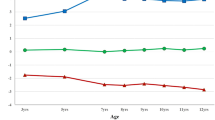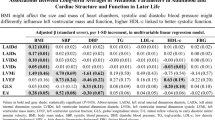Abstract
The childhood high body mass index (BMI) is associated with cardiovascular risk, but the association between childhood BMI trajectory patterns and cardiovascular risk remains unclear. The purposes of this study are to identify subgroups of individuals with similar trajectories in BMI during childhood, and to determine the relationship of childhood BMI trajectories with subclinical cardiovascular disease in young adulthood, indexed by intima-media thickness (IMT) and left ventricular mass index (LVMI). The participants were from the Georgia Stress and Heart (GSH) study. A total of 626 participants with BMI measured 3–12 times during childhood (5–18 years old) were included. By using latent class models, three trajectory groups in BMI were identified, including high increasing (HI), moderate increasing (MI) and normal group. We found that childhood trajectory of BMI was significantly associated with IMT and LVMI in young adulthood even after adjustment for BMI in young adulthood. Our results suggested that different BMI trajectory patterns exist during childhood. We for the first time reported the association between childhood BMI trajectory patterns and subclinical cardiovascular risk in young adulthood, indicating that monitoring trajectories of BMI from childhood may help to identify a high cardiovascular risk population in early life.
This is a preview of subscription content, access via your institution
Access options
Subscribe to this journal
Receive 12 print issues and online access
$259.00 per year
only $21.58 per issue
Buy this article
- Purchase on Springer Link
- Instant access to full article PDF
Prices may be subject to local taxes which are calculated during checkout

Similar content being viewed by others
References
Litwin SE . Childhood obesity and adulthood cardiovascular disease: quantifying the lifetime cumulative burden of cardiovascular risk factors. J Am Coll Cardiol 2014; 64: 1588–1590.
Mozaffarian D, Benjamin EJ, Go AS, Arnett DK, Blaha MJ, Cushman M et al. Heart disease and stroke statistics—2015 update: a report from the American Heart Association. Circulation 2015; 131: e29–322.
Praveen PA, Roy A, Prabhakaran D . Cardiovascular disease risk factors: a childhood perspective. Indian J Pediatr 2013; 80: S3–12.
Sahoo K, Sahoo B, Choudhury AK, Sofi NY, Kumar R, Bhadoria AS . Childhood obesity: causes and consequences. J Family Med Prim Care 2015; 4: 187–192.
Attard SM, Herring AH, Howard AG, Gordon-Larsen P . Longitudinal trajectories of BMI and cardiovascular disease risk: the national longitudinal study of adolescent health. Obesity 2013; 21: 2180–2188.
Thompson AL, Koehler E, Herring AH, Paynter L, Du S, Zhang B et al. Weight gain trajectories associated with elevated C-reactive protein levels in Chinese adults. J Am Heart Assoc 2016; 5: e003262.
Berenson GS . Childhood risk factors predict adult risk associated with subclinical cardiovascular disease. The Bogalusa Heart Study. Am J Cardiol 2002; 90: 3L–7L.
Li L, Hardy R, Kuh D, Power C . Life-course body mass index trajectories and blood pressure in mid life in two British birth cohorts: stronger associations in the later-born generation. Int J Epidemiol 2015; 44: 1018–1026.
Su S, Wang X, Pollock JS, Treiber FA, Xu X, Snieder H et al. Adverse childhood experiences and blood pressure trajectories from childhood to young adulthood: the Georgia stress and Heart study. Circulation 2015; 131: 1674–1681.
Mosteller RD . Simplified calculation of body-surface area. N Engl J Med 1987; 317: 1098.
Devereux RB, Lutas EM, Casale PN, Kligfield P, Eisenberg RR, Hammond IW et al. Standardization of M-mode echocardiographic left ventricular anatomic measurements. J Am Coll Cardiol 1984; 4: 1222–1230.
Noble EE, Billington CJ, Kotz CM, Wang C . The lighter side of BDNF. Am J Physiol 2011; 300: R1053–R1069.
McCutcheon AL . Latent Class Analysis. SAGE Publications: Newbury Park, CA, USA, 1987.
Jones BL, Nagin DS . A note on a stata plugin for estimating group-based trajectory models. Sociol Methods Res 2013; 42: 608–613.
JONES BL, NAGIN DS, ROEDER KA . SAS Procedure based on mixture models for estimating developmental trajectories. Sociol Methods Res 2001; 29: 374–393.
Baldassarre D, Hamsten A, Veglia F, de Faire U, Humphries SE, Smit AJ et al. Measurements of carotid intima-media thickness and of interadventitia common carotid diameter improve prediction of cardiovascular events: results of the IMPROVE (Carotid Intima Media Thickness [IMT] and IMT-Progression as Predictors of Vascular Events in a High Risk European Population) study. J Am Coll Cardiol 2012; 60: 1489–1499.
Liao J, Karnik R, Gu H, Ziller MJ, Clement K, Tsankov AM et al. Targeted disruption of DNMT1, DNMT3A and DNMT3B in human embryonic stem cells. Nat Genet 2015; 47: 469–478.
Ostbye T, Malhotra R, Landerman LR . Body mass trajectories through adulthood: results from the National Longitudinal Survey of Youth 1979 Cohort (1981-2006). Int J Epidemiol 2011; 40: 240–250.
Koning M, Hoekstra T, de Jong E, Visscher TL, Seidell JC, Renders CM . Identifying developmental trajectories of body mass index in childhood using latent class growth (mixture) modelling: associations with dietary, sedentary and physical activity behaviors: a longitudinal study. BMC Public Health 2016; 16: 1128.
Wilmoth JM, London AS, Himes CL . Inter-cohort variation in the consequences of US Military Service for men's mid- to late-life body mass index trajectories. In: Burton-Jeangros C, Cullati S, Sacker A, Blane D (eds). A Life Course Perspective on Health Trajectories and Transitions: Cham (CH) 2015.
Acknowledgements
We thank all the participants in the study and the staff at the Georgia Prevention Institute. The present study was supported in part by NIH/NHLBI HL69999 and HL125577.
Author information
Authors and Affiliations
Corresponding author
Ethics declarations
Competing interests
The authors declare no conflict of interest.
Rights and permissions
About this article
Cite this article
Hao, G., Wang, X., Treiber, F. et al. Body mass index trajectories in childhood is predictive of cardiovascular risk: results from the 23-year longitudinal Georgia Stress and Heart study. Int J Obes 42, 923–925 (2018). https://doi.org/10.1038/ijo.2017.244
Received:
Revised:
Accepted:
Published:
Issue Date:
DOI: https://doi.org/10.1038/ijo.2017.244
This article is cited by
-
Association between BMI trajectories from childhood to early adulthood and the carotid intima-media thickness in early adulthood: Tehran lipid and glucose study
BMC Public Health (2023)
-
Abdominal obesity-related lipid metabolites may mediate the association between obesity and glucose dysregulation
Pediatric Research (2023)
-
The associations of maternal and paternal obesity with latent patterns of offspring BMI development between 7 and 17 years of age: pooled analyses of cohorts born in 1958 and 2001 in the United Kingdom
International Journal of Obesity (2023)
-
Predictive value of women’s weight trajectories in determining familial cardiovascular disorders: a family-based longitudinal study
Scientific Reports (2021)
-
Adolescent and Childhood Obesity and Excess Morbidity and Mortality in Young Adulthood—a Systematic Review
Current Obesity Reports (2021)



